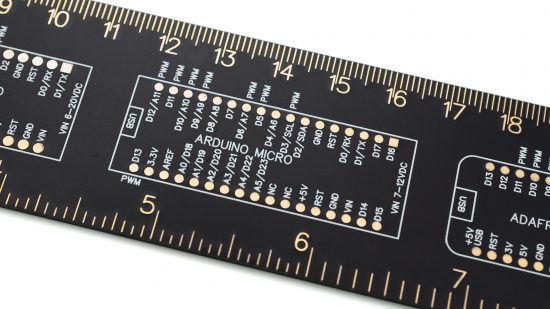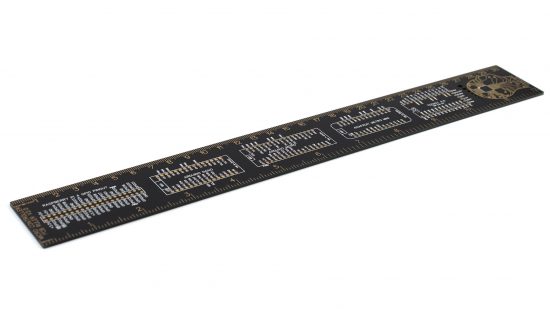What is a ruler? A piece of plastic, wood or metal you can use to measure lengths and draw straight lines. PCB rulers, though, are different – and not just because they’re almost completely inflexible, being made out of rigid fibreglass and copper. Sure, you can use them to measure lengths or draw straight lines, but they’re designed to act as desk-based reference guides too.
Bolt Industries’ Ian Dunn is no stranger to PCB rulers. Now on his third generation of crowdfunded PCB ruler designs, he’s been refining his art – and the latest design packs a wealth of information into a surprisingly small space. The front of Dunn’s latest ruler design carries, as you might expect, length markings in inches and millimetres. These start, pleasingly, right at the edge, so you can push the smaller edge up against the object you want to measure.
The bulk of the front, though, is taken up by pin-out references for a range of popular microcontrollers: The Arduino Nano, Arduino Micro, Teensy 4.0 and Raspberry Pi Pico, which replaces the Adafruit Metro Mini reference from earlier designs. There’s also a reference for the 40-pin general-purpose input/output (GPIO) header on Raspberry Pi single-board computers.

Each microcontroller is represented as a full footprint, making it easy to figure out which pin is where on the physical device. The references continue on the back, where you’ll find guides for common through-hole components, including various switches and LEDs, resistors, capacitors, transistors, voltage regulators and diodes.
It’s not just symbols and pin-outs either – the resistor section includes a guide to decoding the colour bands, and the LED section has a reminder of which leg is the anode and which is the cathode. Likewise, the capacitor section has a three-way conversion table between micro-, nano- and pico-farads, and the transistor sections looks at the inner workings of PNP, NPN, NMOS and PMOS transistors. There’s even a copy of Ohm’s law, plus a table of common diode types and their ratings.
Dunn isn’t done there though. For those looking to design their own PCBs, or reverse-engineer someone else’s PCB, there are copper traces to the left of the ruler, which include their measurements in millimetres and mils, plus the maximum current they can carry. Next to these are a number of holes through which you can push wires in order to get their measurements in American Wire Gauge (AWG). There’s even a reference guide for font height.
Compared with earlier designs, Dunn’s latest ruler focuses a little less on component footprints and more on references. The seven switch footprints of the 2nd-generation rulers have been dropped to just two, making room for a new reference guide to logic gates.
Meanwhile, the USB pin-outs have been dropped altogether, and the footprints for capacitors have been replaced with a guide to reading the numerical codes printed on the front of ceramic disc capacitors. While the new design makes it harder to pull a component out of your bits box and quickly figure out its footprint, it’s definitely more useful as a general guide to electronics.
Following a successful crowdfunding campaign on Kickstarter, Dunn is taking pre-orders for the rulers at $14 US (around £10 ex VAT). Alternatively, the PCB production files are available to download under an open-source licence.
Price
$14 US (around £10 ex VAT)
Related: Click here if you are looking for Roblox Custom PC Tycoon codes.
